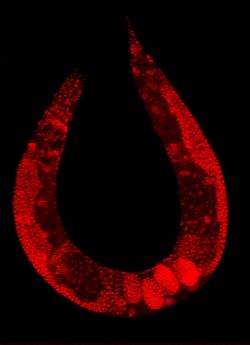عديد الخلايا

الكائن Multicellular organism ذو الخلايا العديدة هو كائن حي الذي لديه أكثر من خلية واحدة، ولديه خلاية مختلفة كل منها لها مهمة متخصص بها. معظم الأحياء الذي يراها الشخص بعينيه هو كائنات حية لدى الخلايا العديدة، من الحيوانات والنبات.
All species of animals, land plants and most fungi are multicellular, as are many algae, whereas a few organisms are partially uni- and partially multicellular, like slime molds and social amoebae such as the genus Dictyostelium.[1][2]
Multicellular organisms arise in various ways, for example by cell division or by aggregation of many single cells.[3][2] Colonial organisms are the result of many identical individuals joining together to form a colony. However, it can often be hard to separate colonial protists from true multicellular organisms, because the two concepts are not distinct; colonial protists have been dubbed "pluricellular" rather than "multicellular".[4][5] There are also multinucleate though technically unicellular organisms that are macroscopic, such as the xenophyophorea that can reach 20 cm.
التاريخ التطوري
التواجد
فرضيات الأصل
نظرية المستعمرة
انظر أيضاً
المصادر
- ^ Chimileski, Scott; Kolter, Roberto (2017). Life at the Edge of Sight: A Photographic Exploration of the Microbial World. Harvard University Press. ISBN 9780674975910.
- ^ أ ب Lyons, Nicholas A.; Kolter, Roberto (April 2015). "On the evolution of bacterial multicellularity". Current Opinion in Microbiology. 24: 21–28. doi:10.1016/j.mib.2014.12.007. ISSN 1879-0364. PMC 4380822. PMID 25597443.
- ^ S. M. Miller (2010). "Volvox, Chlamydomonas, and the evolution of multicellularity". Nature Education. 3 (9): 65.
- ^ Brian Keith Hall; Benedikt Hallgrímsson; Monroe W. Strickberger (2008). Strickberger's evolution: the integration of genes, organisms and populations (4th ed.). Hall/Hallgrímsson. p. 149. ISBN 978-0-7637-0066-9.
- ^ Adl, Sina; et al. (October 2005). "The New Higher Level Classification of Eukaryotes with Emphasis on the Taxonomy of Protists". J. Eukaryot. Microbiol. 52 (5): 399–451. doi:10.1111/j.1550-7408.2005.00053.x. PMID 16248873. S2CID 8060916.
